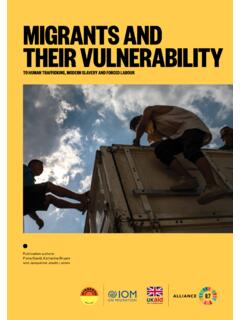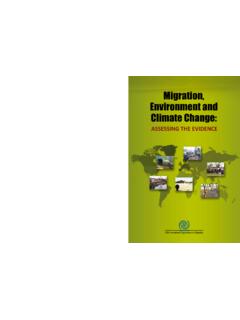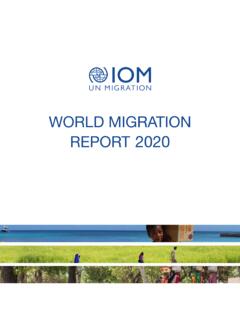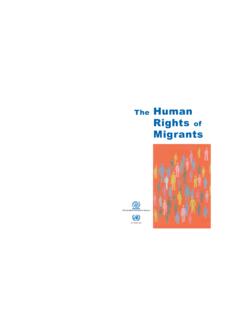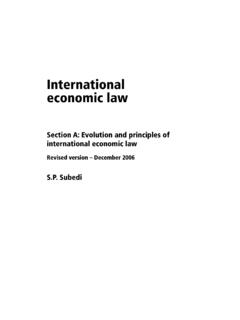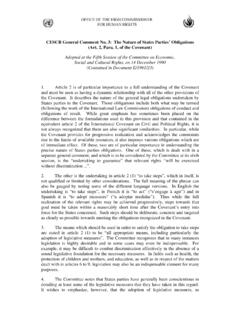Transcription of IOM DATA PROTECTION MANUAL
1 ! ! ! " ###############$ %& %'%% ( %) * + ,-% '' &%& )% %% . / ,-% '' &)0 1% 23 4" 56 77 ###############8 '3%3 9 :; 8 < = " >############### ? -'#%% IOM data PROTECTION MANUAL FOREWORDData PROTECTION is an area of law that is constantly evolving. This is due to privacy concerns associated with the rapid growth of information technology and the fact that data are digitally transferable and easily accessible. The increased incidences of data theft, data loss, and unauthorized or inappropriate use and disclosure of personal data have resulted in questions relating to the effective implementation of laws and policies.
2 In addition, the use of advanced technology in migration management and document fraud presents diverse challenges linked to data PROTECTION and human rights. These concerns are compounded in situations where inadvertent disclosure could result in harm or threat to the safety of individuals. Regardless of regular or irregular movements, when individuals reveal their personal data for a particular purpose, it should be handled with due care to protect their best interests and to ensure that they are fully aware of any implication on their human rights. The international standards for collecting and processing personal data are acknowledged worldwide.
3 However, the lack of a binding international instrument has been the subject of much debate. At the 31st international Conference of data PROTECTION and Privacy Commissioners, a resolution was adopted by a number of States calling for a universal convention and recognizing that data PROTECTION and privacy are fundamental rights attributed to all individuals, irrespective of nationality or residence. It is IOM s hope that content of this publication will add to the discussion of stakeholders, both nationally and internationally. Notwithstanding the vast literature on this issue, there is limited guidance on protecting personal data in the context of migration.
4 IOM is pleased to make an early contribution to the ongoing discussions on data PROTECTION and we encourage further engagement on this important issue. By way of background, IOM conducted a survey of selected registration projects in 26 field offices in 2007. The survey illustrated that there was indeed a need to standardize the handling of personal data throughout the Organization. IOM s policy on data PROTECTION is informed by relevant international standards, in particular the core data PROTECTION principles as recognized by many States, and through research on policies and procedures in other organizations.
5 The IOM data PROTECTION principles are designed to assist IOM staff to take reasonable and necessary precautions in order to preserve the confidentiality of personal data and to ensure that the rights and interests of IOM beneficiaries are adequately protected. IOM s policy on data PROTECTION has been in force since May 2009 and lessons are learned on a daily basis. Although the content of this publication was developed for IOM use, it can be used as a resource tool by other organizations operating in similar contexts. As a final point, acknowledgement is due to the author, Ruzayda Martens, for developing IOM s strategy on this issue and for advancing data PROTECTION as a necessary consideration in IOM s Perruchoud data Protection3 ACKNOWLEDGEMENTSThe author would like to thank current and former IOM colleagues who pioneered the Technology Application and Migration Management (TAMM)
6 data PROTECTION Project, a joint effort between the Department of Migration Management, the Department of Information Technology and Communications, and the international Migration Law and Legal Affairs Department. The Project benefited from the experience and expertise of a wide range of IOM colleagues, both in the Field and at Headquarters. Sincere thanks and appreciation are due to the Project Team, Steering Committee and Working Group members who took time out of their busy schedules to contribute at various stages of the project. Firstly, particular thanks to the Project Team members: Shp tim Spahiya for his contribution and support in the timely completion of the project and to Chiara Frattini, Jacqueline Straccia and Elif Celik for their research assistance.
7 Secondly, much appreciation to the Steering Committee members: Yorio Tanimura, Jillyanne Redpath-Cross and Bernardo Mariano for their expert guidance and indispensible contributions. Thirdly, special thanks to the Working Group members for their commitment and detailed feedback: Nicholas Theotocatos, Norbert W hler, Monica Halil, Walter Brill, Sarah Craggs, Delbert Field, Lea Matherson, Jobste Koheler, Christopher Gascon, Elizabeth Dunlap, Dyane Epstein, Goran Grujovic, Chintana Meegamarachchi, Mariko Tomiyama, Teresa Zakaria and Jesus Sarol. Valuable comments were also received from various missions and individual colleagues; thanks are due to, amongst others: Jonathan Martens, Miwa Takahashi, Ashraf El-Nour, Richard Scott, Mio Sato, Amy Mahoney, Daniel Redondo, Ricardo Cordero, Tanja Brombacher, Mark Brown, Nasim Faruk, William Barriga, Gloria Ko, Patrick Corcoran, Abye Makonnen, Ramiro Nochez-McNutt, Anna Eva Randicetti, and Robert Villamor.
8 Finally, I wish to express my gratitude to Richard Perruchoud for his continuous support and to my colleagues at the Office of Legal Affairs for their efforts to promote data PROTECTION in their daily Martens11 Legal Officer, IOM Geneva. It should be noted that the data PROTECTION Guidelines were developed to assist in the application of the 13 IOM data PROTECTION principles . The views, findings, interpretations and conclusions expressed in the data PROTECTION Guidelinesare those of the author and the responsibility for any error remains that of the Protection5 TABLE OF CONTENTS PAGE Introduction PART I IOM data PROTECTION principles PART II data PROTECTION Guidelines How to use the guidelines ygolonimreTData PROTECTION data subjects Personal data data processing Risk benefit assessment data controllers Guiding points on IOM principles Principle 1: Lawful and fair collection Principle 2.
9 Specified and legitimate purpose Principle 3: data quality Principle 4: Consent Principle 5: Transfer to third parties Principle 6: Confidentiality Principle 7: Access and transparency Principle 8: data security Principle 9: Retention of personal data Principle 10: Application of the principles Principle 11: Ownership of personal data Principle 12: Oversight, compliance and internal remedies Principle 13: Exceptions Consideration boxes 1. Ethical considerations 2. List of personal data 3. Sensitivity assessment 4. Risk action indicators 5. Effective risk benefit assessment 6. Legal considerations 7. Fairness considerations 8.
10 Compatibility considerations 9. Research considerations 10. Reasonable steps to ensure accuracy 11. Assessing continued relevance 12. Consent considerations 13. Respecting vulnerability 14. Foreseeable third parties 15. Indicators for written transfer contract 16. Confidentiality indicators 17. Complaint considerations 18. Access considerations 19. Culture of data security indicators 20. Consideration for electronic records 21. Retention period 22. Further retention considerations 23. Destruction considerations 24. Depersonalizing personal data 25. Ownership considerations 26. Compliance and oversight considerations 27. Derogation considerations Annexure A: List of international instruments Annexure B: List of national legislation yrassolG yhpargoilbiBPART III IOM Generic Templates and Checklists data Protection151618192539495769798595105107 1091151277911131313131414336391101 INTRODUCTIONThe collection and processing of personal data are necessary components of IOM s commitment to facilitate migration movements, understand migration challenges, and respect the human dignity and well-being of migrants.


